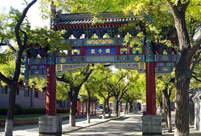 Post-90s beauty boxer grapples four men
Post-90s beauty boxer grapples four men
 3,000-year-old tea town through lenses
3,000-year-old tea town through lenses
 22 archaeological sites along Silk Road in China
22 archaeological sites along Silk Road in China
 Football babies, Samba dancers embrace 'World Cup'
Football babies, Samba dancers embrace 'World Cup'
 Beautiful scenery along China’s Grand Canal
Beautiful scenery along China’s Grand Canal
 High speed train attendants receive training in Chongqing
High speed train attendants receive training in Chongqing
 Rare rainbow clouds seen in Fujian
Rare rainbow clouds seen in Fujian
 Small bracelet going global
Small bracelet going global
 Aerial Photography: Amazing Tianshan Mountains
Aerial Photography: Amazing Tianshan Mountains
 'Animals' in 2014 World Cup
'Animals' in 2014 World Cup
ASHGABAT, July 2 -- The Silk Road initiative envisages common visions of China and Turkmenistan for closer regional cooperation and transport connectivity, Turkmen officials have said.
Turkmen President Gurbanguly Berdymukhamedov, during a meeting with visiting Armenian President Serzh Sargsyan in April, said his country has been working on East-West transport connectivity in the region.
Underlining the importance of modern infrastructure for economic development, Berdymukhamedov said Turkmenistan and Armenia could collaborate on international projects on transport and communications.
Currently, the work on the TAT rail connecting Turkmenistan, Afghanistan and Tajikistan is underway, while the Kazakhstan-Turkmenistan-Iran railway line is expected to come into operation this year.
The Central Asia-Middle East transportation corridor is also expected to be fully established this year.
Those ongoing projects are part of the efforts to turn the landlocked Central Asia into a transit corridor between the East and the West, enabling closer economic and trade ties among regional partners.
Similarly, the Economic Silk Road of China campaigns for quicker and easier movement of goods from China to Europe, the Middle East, and Central and South Asia.
China's initiatives to build the Silk Road economic belt and a 21st-century maritime Silk Road, known for short as the Belt and the Road, were put forth by Chinese President Xi Jinping during his two separate visits to Central Asia and Southeast Asia last fall.
China's Silk Road concept is fully compatible with the transport and communications initiatives of Turkmenistan.
Just like the ancient Silk Road, the concept of the envisioned Silk Road economic belt does not advocate a rigidly defined route from point A to point B. It is all about connectivity, easy movement of cargo and people, and harmonization of tariffs and procedures.
China has fully matched its words with deeds. In 2011, China launched a railway linking China's western Chongqing city and Xinjiang Uygur autonomous region and the German city of Duisburg, the world's biggest inland harbor and a European transport and logistics hub.
In 2013, an express train from southwest China's Sichuan province to Lodz in central Poland was inaugurated.
The economic benefits of rail links to Europe are huge. The China-Europe railway transport is considerably quicker than sea passage that usually takes about 40 to 50 days, with much cheaper costs than air cargo.
Moreover, railway transport enables more convenient trans-shipments and more rapid transport to the final destination.
Along with universal connectivity, China calls for the creation of new development zones along the Economic Silk Road. This will help improve the livehood and economic conditions in countries and regions within the Silk Road economic belt, local experts said.
The Silk Road initiative is a broad and flexible concept, offering various solutions for all kinds of problems.
Most of the countries along the Silk Road landmass are working closely with each other, and there is no desire by any country to claim the sole credit for the idea.
What is important for all is the joint work for common prosperity and peace, as it is also the spirit of the ancient Silk Road.
 Featured hutongs in Beijing
Featured hutongs in Beijing Separate college entrance exam
Separate college entrance exam Flash mob dance
Flash mob dance Picturesque scenery of Ghost City
Picturesque scenery of Ghost City Children attend First Writing Ceremony
Children attend First Writing Ceremony Female master poses for graduation photos with son
Female master poses for graduation photos with son Silk Road, China's Grand Canal listed as World Heritage Sites
Silk Road, China's Grand Canal listed as World Heritage Sites PKU students imitate famous paintings in real-person photos
PKU students imitate famous paintings in real-person photos Chinese 'Slumdog Millionaire'
Chinese 'Slumdog Millionaire' Islands in S. China Sea better shown on new vertical atlas of China
Islands in S. China Sea better shown on new vertical atlas of China Girl takes father’s portrait to travel the world
Girl takes father’s portrait to travel the world Images of Xi'an: Part one
Images of Xi'an: Part one In Pictures: Female fans of World Cup
In Pictures: Female fans of World Cup Top 20 hottest women in the world in 2014
Top 20 hottest women in the world in 2014  China's top 10 representative architectures
China's top 10 representative architecturesDay|Week|Month